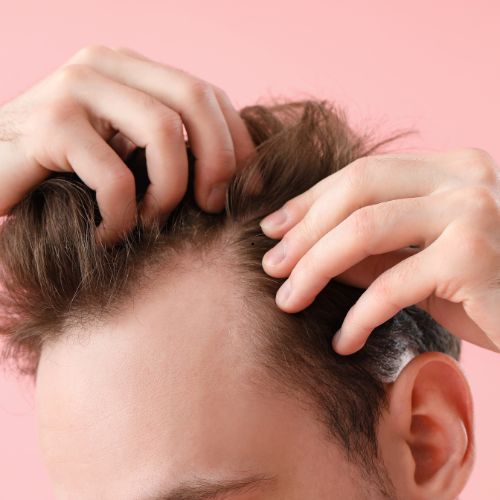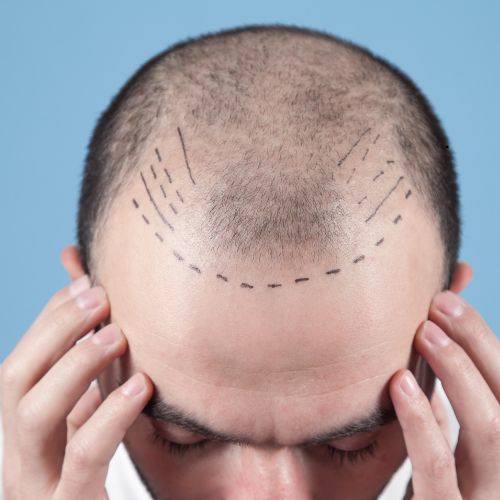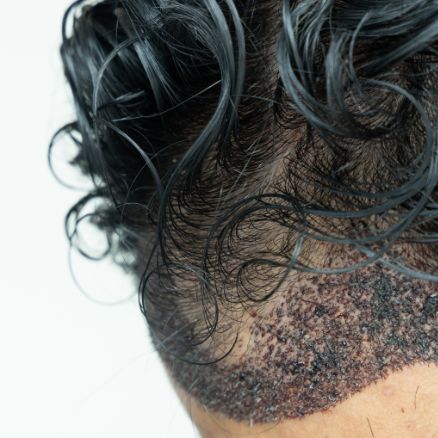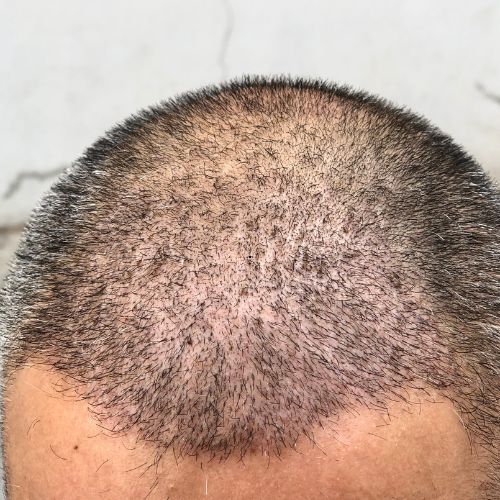
Experiencing hair loss can adversely affect your self-confidence and self-image; nevertheless, a hair transplant serves as a permanent solution to reinstate your natural hairline. Our skincare clinic is equipped with advanced hair transplant procedures to assist you in regaining a fuller appearance of hair. Here’s everything you need to know about hair transplants, including their features, benefits, and treatment process.
Hair transplantation involves surgically relocating hair follicles. Hair is harvested from a donor area, typically the back or sides of the scalp, and transplanted to thinning or balding areas. This procedure effectively addresses hair loss conditions like male and female pattern baldness, providing a permanent and natural-looking solution.

The transplanted hair grows naturally and blends seamlessly with your existing hair.
The hair follicles transplanted are resistant to the effects of hair loss, providing long-lasting results.
The procedure is tailored to your specific hair loss pattern, ensuring the most effective and aesthetically pleasing outcome.
Modern methods like Follicular Unit Extraction (FUE) and Follicular Unit Transplantation (FUT) provide precise, minimally invasive hair restoration options.
Regain a natural-looking hairline that enhances your facial features.
Improve hair density in thinning areas, providing a fuller and thicker appearance.

Feel more confident and confident with a restored head of hair.
The transplanted hair requires no special maintenance beyond regular hair care routines.
Start with an in-depth consultation to assess your hair loss pattern, discuss your goals, and determine the most suitable transplant technique for you.

The donor and recipient areas are marked, and the scalp is cleaned. Local anesthesia is applied to ensure comfort during the procedure.


The extraction of individual hair follicles from the donor site is performed with a specialized tool, followed by their implantation into regions that are thinning or devoid of hair.

A strip of scalp is removed from the donor area, and the follicles are carefully dissected before being implanted into the recipient area. The procedure can take several hours, depending on the transplant's size.
You may experience mild swelling, redness, or discomfort, which typically subsides within a few days. Follow the post-care instructions provided by our specialists, including avoiding strenuous activities and protecting the scalp from sun exposure.

A hair transplant is a surgical procedure that involves moving hair follicles from a donor site, usually the back or sides of the scalp, to areas with thinning or balding hair. The procedure is performed under local anesthesia, and the hair follicles are carefully transplanted into the thinning areas. The transplanted hair follicles will eventually grow new hair, providing a natural-looking solution to hair loss. The technique used can be Follicular Unit Extraction (FUE) or Follicular Unit Transplantation (FUT), depending on the patient’s needs and goals.
Ideal candidates for a hair transplant are individuals who are experiencing pattern baldness or thinning hair and have sufficient donor hair on the scalp or other areas of the body. Both men and women can benefit from hair transplants. It’s important that candidates have realistic expectations and understand that results may take several months to become fully visible. A thorough evaluation by our specialists will determine if a hair transplant is the right option based on the extent of hair loss and overall health.
Follicular Unit Extraction (FUE) involves individually extracting hair follicles from the donor area using a tiny punch tool and then implanting them into the recipient area. This method leaves minimal scarring and offers quicker recovery. Follicular Unit Transplantation (FUT), also known as strip harvesting, involves removing a strip of scalp from the donor area, dissecting it into follicular units, and then transplanting these units. FUT may be suitable for patients requiring a larger number of grafts and leaves a linear scar, but it typically offers faster graft collection.
After a hair transplant, you may experience some swelling, redness, and minor discomfort in the donor and recipient areas. These effects typically subside within a few days. You may also notice scabbing and shedding of the transplanted hair in the initial weeks, which is a normal part of the process. Full results generally become visible within 6 to 12 months as new hair begins to grow. Our team provides detailed aftercare instructions to ensure a smooth recovery and optimal results.
The duration of a hair transplant procedure depends on the technique used and the extent of the treatment area. On average, an FUE or FUT procedure can take between 4 to 8 hours. The procedure is performed under local anesthesia, so patients are awake but comfortable throughout. Larger areas or more complex cases may require multiple sessions or a full day to complete.
Yes, the results of a hair transplant are generally permanent. The transplanted hair follicles are taken from areas of the scalp that are resistant to hair loss, so they should continue to grow for a lifetime. However, it’s important to note that while the transplanted hair is permanent, natural hair loss can still occur in non-transplanted areas. Ongoing care and maintenance, such as using appropriate hair care products and possibly medications, can help ensure long-term hair health.
The cost of a hair transplant varies depending on factors such as the technique used (FUE or FUT), the number of grafts required, and the complexity of the procedure. During your initial consultation, we provide a detailed cost estimate and discuss available financing options. Our goal is to ensure that you understand the investment required and are comfortable with the financial aspects of your treatment.
Most patients can return to work within a few days after a hair transplant, depending on their job and personal comfort level. While there is minimal downtime, some patients may experience mild swelling or redness that could be noticeable. We recommend taking a few days off if your work involves physical activity or if you prefer to recover privately. Our team will provide guidance on how to manage your recovery and when it’s safe to resume normal activities.
Hair transplants are generally safe with minimal risk. However, potential side effects may include temporary swelling, redness, or discomfort in the donor and recipient areas. Rarely, complications such as infection or poor graft survival can occur. Our clinic follows strict sterilization and safety protocols to minimize risks, and we provide detailed aftercare instructions to ensure a smooth recovery. If any concerns arise, our team is available to address them promptly.
Our clinic in Perinthalmanna is renowned for its expertise in hair transplantation, offering advanced techniques and personalized care. We use state-of-the-art technology and have a team of experienced professionals dedicated to achieving the best possible results. Our approach focuses on thorough consultation, customized treatment plans, and exceptional aftercare to ensure that you receive the highest quality service and achieve natural-looking, long-lasting results.
Our Perinthalmanna clinic offers advanced hair transplant procedures performed by skilled surgeons. Using the latest techniques, we deliver natural-looking and long-lasting results. With a personalized approach, we create designed treatment plans to help you achieve your desired hair goals.